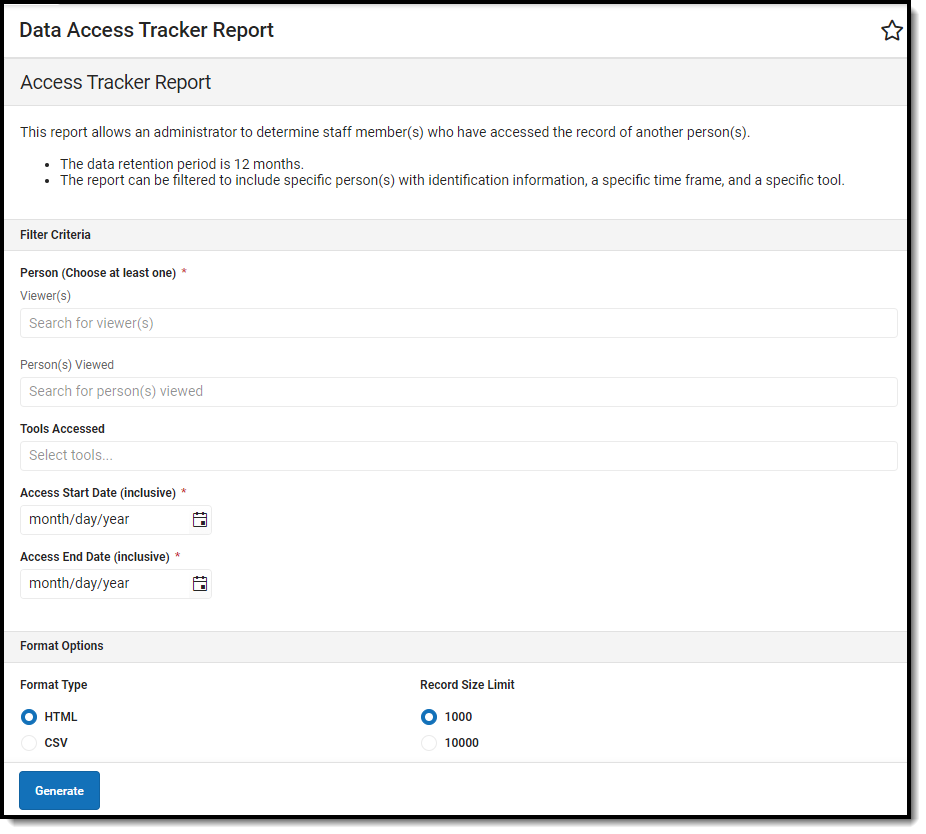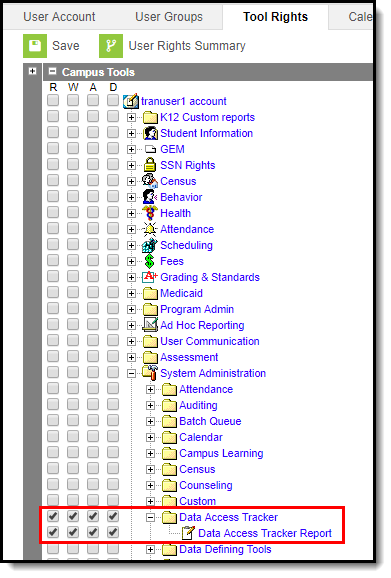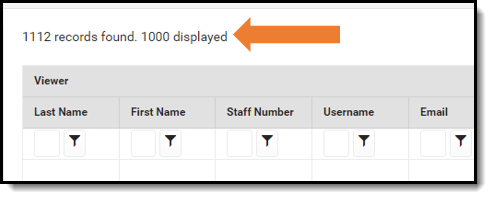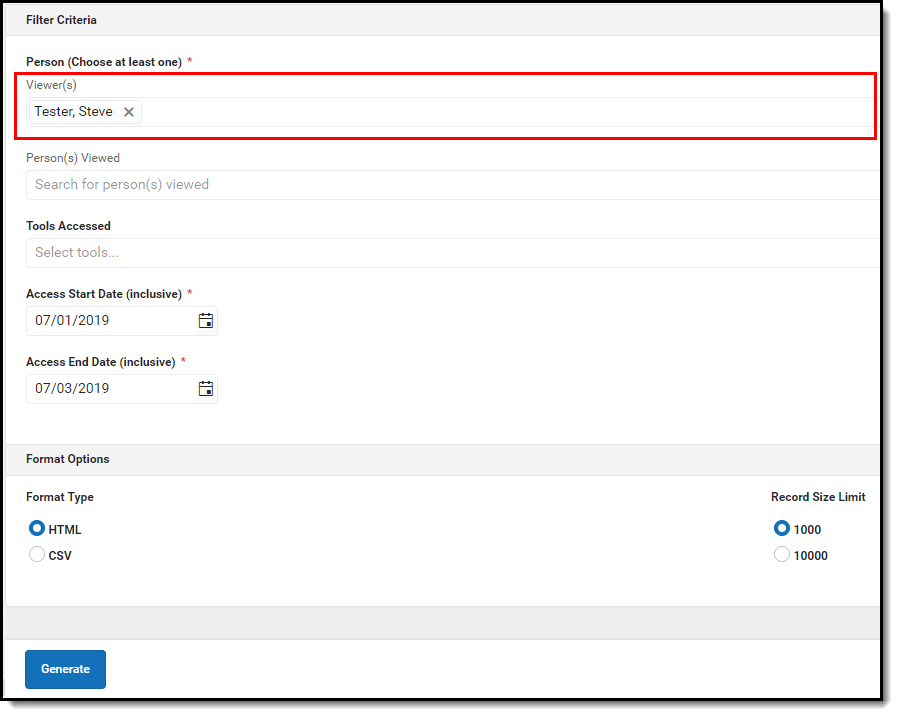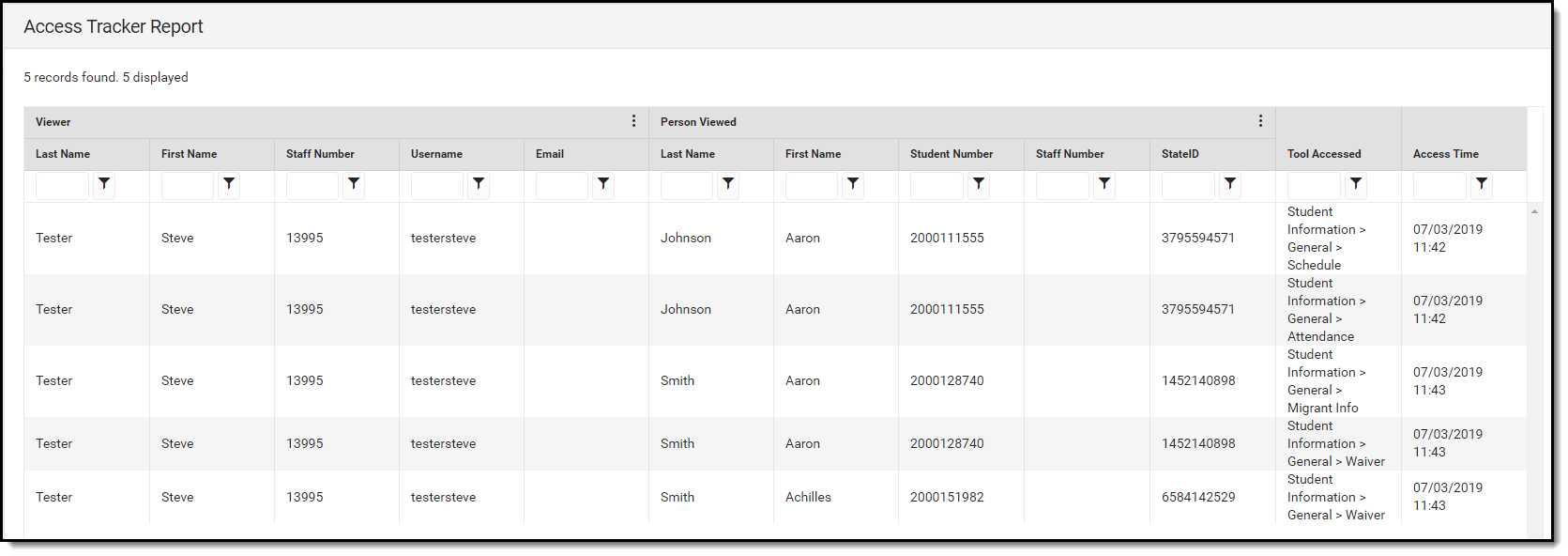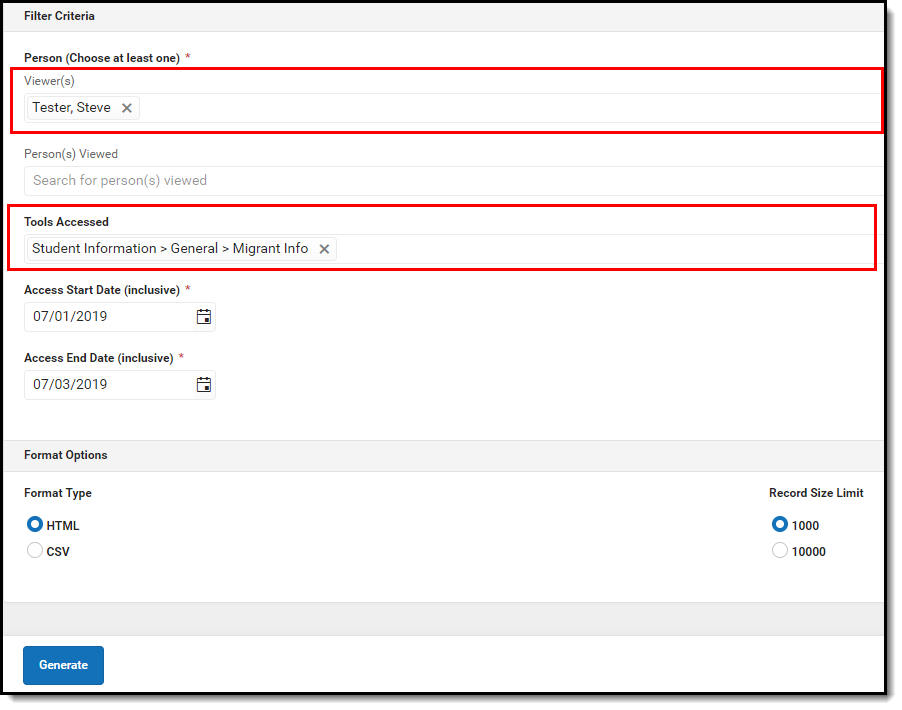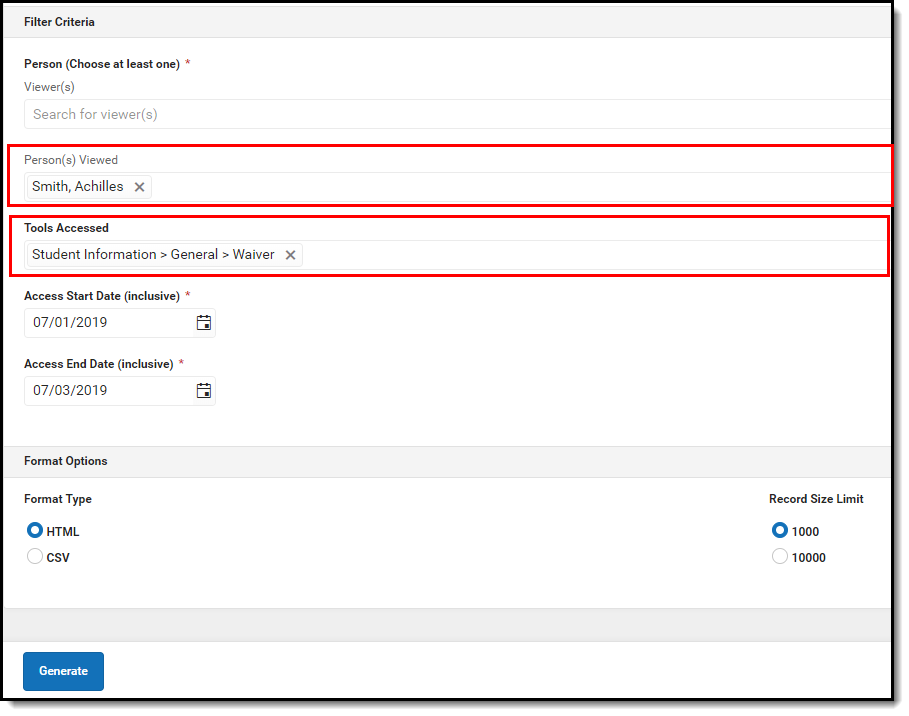PATH: System Administration > Data Access Tracker > Data Access Tracker Reports
Search Term: Data Access Tracker Report
The Data Access Tracker Report provides principals, superintendents, and other appropriate staff members with the ability to audit and review information about all users who viewed one or more specific students or users’ data, when they viewed this data, and what tools they used to view this data. Using this tool, districts can monitor and protect personal, private, and sensitive user data by identifying exactly who is accessing this information and determining its appropriateness.
Currently this functionality is only available for a select set of customers.
This article covers the following topics:
Image 1: Data Access Tracker Report
Tool Rights
PATH: System Administration > User Security > User > Tool Rights
In order to generate this report, users must have at least R(ead) tool rights assigned for the tool.
Image 2: Data Access Tracker Report Tool Rights
Auditing Records Accessed By a Specific Person(s)
One scenario for using this report is to audit what records were viewed by a specific person(s) during a specific timeframe. For example in the image below, the report would indicate all records viewed by Steve Tester between 07/01/2019-07/03/2019.
To review this data:
- Enter the name of the Viewer(s). This is the person(s) you wish to audit the records they viewed.
- Enter the Access Start Date. This is the first day in the audit timeframe. Records accessed on this day through the Access End Date are reported.
- Enter the Access End Date. This is the last day in the audit timeframe.
- Select the Format Type.
- Determine the Record Size Limit. If the number of records reported exceeds this limit, you will receive a notification and will not be able to view records beyond this size limit.
- Click Generate. The screen will refresh and present applicable records (Image 4).
Image 3: Auditing Records Viewed by a Specific Person
Reported records will appear in a table, describing data about the viewer (Last Name, First Name, Staff Number, Username, Email), information about the person (records) viewed (Last Name, First Name, Student Number, Staff Number, State ID), the tool used to view the records, and the timestamp of when the viewer viewed the records (Image 4).
Image 4: Report Results
Auditing Records Accessed for a Specific Tool(s) by a Specific Person(s)
This report can help you identify which records were viewed for a specific tool by a specific person(s). For example in the image below. the report would indicate which Migrant Info records were viewed by Steve Tester between 07/01/2019-07/03/2019.
To review this data:
- Enter the name of the Viewer(s). This is the person(s) you wish to audit the records they viewed.
- Enter the Tools Accessed. This is the tool(s) accessed by the viewer to view records.
- Enter the Access Start Date. This is the first day in the audit timeframe. Records accessed on this day through the Access End Date are reported.
- Enter the Access End Date. This is the last day in the audit timeframe.
- Select the Format Type.
- Determine the Record Size Limit. If the number of records reported exceeds this limit, you will receive a notification and will not be able to view records beyond this size limit.
- Click Generate. The screen will refresh and present applicable records (Image 6).
Image 5: Auditing Records for a Specific Tool by a Specific Person
Reported records will appear in a table, describing data about the viewer (Last Name, First Name, Staff Number, Username, Email), information about the person (records) viewed (Last Name, First Name, Student Number, Staff Number, State ID), the tool used to view the records, and the timestamp of when the viewer viewed the records (Image 6).
Image 6: Records Viewed for a Specific Tool by a Specific Person
Auditing Who Accessed Records for a Specific Person(s)
An important scenario for auditing records is to review which people viewed the records of a specific person or student(s). For example in the image below, the report would indicate who viewed Achilles Smith's records during a timeframe of 07/01/2019-07/03/2019.
To review this data:
- Enter the name of the Person(s) Viewed. This is the person(s) who had their records accessed during the timeframe entered.
- Enter the Access Start Date. This is the first day in the audit timeframe. Records accessed on this day through the Access End Date are reported.
- Enter the Access End Date. This is the last day in the audit timeframe.
- Select the Format Type.
- Determine the Record Size Limit. If the number of records reported exceeds this limit, you will receive a notification and will not be able to view records beyond this size limit.
- Click Generate. The screen will refresh and present applicable records (Image 8).
Image 7: Auditing Who Viewed the Records for a Specific Person(s)
Reported records will appear in a table, describing data about the viewer (Last Name, First Name, Staff Number, Username, Email), information about the person (records) viewed (Last Name, First Name, Student Number, Staff Number, State ID), the tool used to view the records, and the timestamp of when the viewer viewed the records (Image 8).
Image 8: Report of Who Viewed Records for a Specific Person
Auditing Who Accessed Records for a Specific Tool(s) for a Specific Person(s)
Another scenario for auditing is to review who viewed the records for a specific tool and person. For example in the image below, the report would indicate who viewed Achilles Smith's Waiver records.
To review this data:
- Enter the name of the Person(s) Viewed. This is the person(s) who had their records accessed during the timeframe entered.
- Enter the Tools Accessed. This is the tool(s) accessed by the viewer to view records.
- Enter the Access Start Date. This is the first day in the audit timeframe. Records accessed on this day through the Access End Date are reported.
- Enter the Access End Date. This is the last day in the audit timeframe.
- Select the Format Type.
- Determine the Record Size Limit. If the number of records reported exceeds this limit, you will receive a notification and will not be able to view records beyond this size limit.
- Click Generate. The screen will refresh and present applicable records (Image 8).
Image 9: Auditing Who Viewed Specific Tool Records for a Specific Person(s).
Reported records will appear in a table, describing data about the viewer (Last Name, First Name, Staff Number, Username, Email), information about the person (records) viewed (Last Name, First Name, Student Number, Staff Number, State ID), the tool used to view the records, and the timestamp of when the viewer viewed the records (Image 10).
Image 10: Report of Who Viewed Specific Tool Records for a Specific Person
Auditing Which Records a Specific Person Viewed for a Specific Tool(s) and Person(s)
This report can also audit which records were viewed by a specific person(s) for a specific tool and person(s). For example in the image below, the report will indicate all Migrant Info records Steve Tester viewed for Aaron Smith (Image 11).
To review this data:
- Enter the name of the Viewer(s). This is the person(s) you wish to audit the records they viewed.
- Enter the name of the Person(s) Viewed. This is the person(s) who had their records accessed during the timeframe entered.
- Enter the Tools Accessed. This is the tool(s) accessed by the viewer to view records.
- Enter the Access Start Date. This is the first day in the audit timeframe. Records accessed on this day through the Access End Date are reported.
- Enter the Access End Date. This is the last day in the audit timeframe.
- Select the Format Type.
- Determine the Record Size Limit. If the number of records reported exceeds this limit, you will receive a notification and will not be able to view records beyond this size limit.
- Click Generate. The screen will refresh and present applicable records (Image 8).
Image 11: Auditing Records Viewed by a Specific Person for a Specific Tool and Person(s)
Reported records will appear in a table, describing data about the viewer (Last Name, First Name, Staff Number, Username, Email), information about the person (records) viewed (Last Name, First Name, Student Number, Staff Number, State ID), the tool used to view the records, and the timestamp of when the viewer viewed the records (Image 12).
Image 12: Report of Which Records Were Reviewed by a Specific Person for a Specific Tool and Person
Filtering Report Data
To assist in auditing report data for a large number of records, each column in the HTML format can be filtered using the text field found under the column name (see image below). For example, entering 'smith' for the Last Name column filtered records to only those with a Last Name value matching 'smith'. You can continue to refine data further by entering filter criteria in a additional columns, such as entering 'Aaron' under the First Name column to filter report data to only records with a Last Name = smith and a First Name = Aaron.
Image 13: Filtering Report Columns - HTML Report Format
You can filter columns based on operators by entering a value in the text field found under the column name and selecting the icon (Image 14). For example in the image below, the State ID column is being filtered by the Contains operator with a value of 145. What this means is that only records with a State ID which contains '145' are displayed.
Image 14: Using a Column Operator - HTML Format
You can also remove columns from the table by clicking the button, unchecking the columns you wish to remove, and clicking Apply (Image 15).
Image 15: Removing Columns from the Table - HTML
If the report is generated in the CSV format, filtering options are determined based on the third-party program used to open the file (i.e., Microsoft Excel).
Image 16: Data Access Tracker Report - CSV Format
